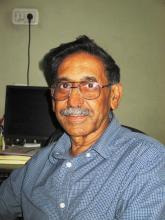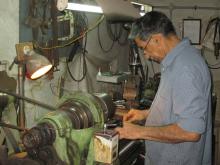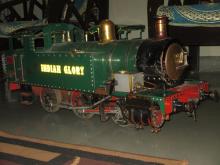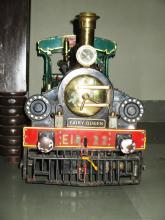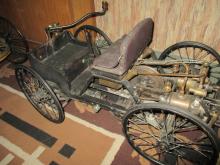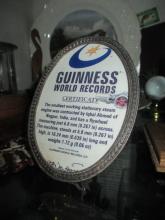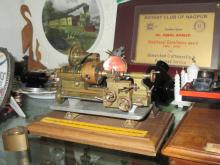This interview first appeared in Vol. 3, No. 1 of The Rail Enthusiast
A working steam engine a mere 1.72 gms, 16 mm long and 6.8 mm high! Difficult to imagine leave alone visualise!! But you can actually see one in Nagpur. All you need to do is visit 71-year old Iqbal Ahmed, master craftsman and modeller, who has perfected the art of miniaturisation of almost anything that works, be it a locomotive, an automobile or a machine tool. He has built such an engine from scratch for which he has received recognition from the Guinness Book of World Records for making the smallest working steam engine in the world.
The Rail Enthusiast Society had the privilege to meet Iqbal Ahmed in December last year. Excerpts from the conversation...
----------------------------------------------------------------------------------------
Rail Enthusiasts’ Society (RES): How and where did you learn the use of a lathe and the skills needed for model making?
Iqbal Ahmed (IA): As an insurance agent in the 1940s, my grandfather used to buy some vehicles that needed to be salvaged and get them renovated by mechanics he hired before offering them for sale. Later, my father took over the business. In the 1960s, insurance became very complicated, so that my father decided to set up a small workshop with a lathe machine, where he began taking up machining jobs for items like bushes, water pumps, and so on. The work was done by hired machinists. I learnt the use of a lathe by observing these machinists and soon began doing jobs myself.
At this stage, we felt that there was not much scope in this type of work. We, therefore, decided to take up specialised jobs. Since funds were scarce, we made attachments for our lathe. Among the attachments were one for milling, another for gear cutting and yet others for drilling, shaping, etc. We thus had one multi-purpose machine that could take up almost any job. This is when we began taking up jobs like spares for printing machines, photographic equipment and, when new items like VCRs came into the market, even parts for them. This is how I honed my skills as a craftsman. It is these skills that I learnt that later developed into making of miniature models.
RES: When did these skills get converted into the fascinating and absorbing hobby of miniature working model making?
IA: Actually, my interest in machines in general and trains in particular started when I was still in my teens. In 1962 or so, my father presented me with an electric operated 13 mm gauge train set, a model of railways in the Swiss Alps. When we started our machine shop, I dismantled the engine completely, copied each part and manufactured my own locomotive. Only, I gave it a WDM2 body. This was my first ever model. Sometime later, some friends presented me with model making books. One of the books had a model of a Simplex 0-6-0 tank loco. Drawings and other details were also given. I found the original dimensions given too big and decided to make my model half of the original size. This is now I got into miniaturisation.
RES: What prompted you to go in for the smallest engine?
IA: My first steam engine was a palm-sized 7” model. I always made working model and did not like static ones. Making models half size of this and finally, quarter size, I finally had a model that was about the size of a matchbox cover. It was then that it was suggested to me to go for a world record. I sent my request for a world record to the Guinness Book of records who rejected it stating that they had a smaller engine that was only 17 mm high and weighed as little as 1.8 gms. I worked hard and ultimately produced an engine that was 16 mm long and weighed only 1.72 gms. I sent my entry to the Guinness Book once again with a video of the working model as well as a weight certificate and other papers. This was accepted and I got a Guinness Book of Records certification for my model.
RES: I understand that you visited Germany to study the models that they have produced.
IA: A relative from Germany presented me with some books, which mentioned xxxx, where you can see the largest model steam loco fleet. This is a huge layout on 5” gauge. I was very keen to go there but did not have the resources. This was some time in 2004. I approached Murli Manohar Joshi, who was then Minister for Science and Technology, for assistance. He was very impressed by my smallest steam engine and agreed to sponsor my trip. That is how I was able to visit Germany. In the meantime, I had already made a working model of a locomotive that I named “Indian Glory”. This was a generic design and not any specific loco. I demonstrated “Indian Glory” at xxx and was appreciated for it.
RES: Tell us about various machinists’ awards that you have won.
IA: Sherline Products Inc. located at Toledo, Ohio, in the USA organises a machinists’ challenge competition regularly. The criterion for the competition is that the final product is of 4 inch cube size. It can be any item. I first made a stationery steam engine in this size and was awarded. In 2005, I made a working model of a lathe machine with all parts. For this, I got the second prize. The organisers also presented me with a model milling machine 18” high. I duplicated this with all its parts within 4”. For this I got the first prize.
Another regular event in the USA is the exhibition of the North American Motor Engineering Society. I wrote to them for permission to exhibit my models. They offered me space and furniture and nothing more. I then approached the Ministry of Science and Technology and they sponsored my trip to the US.
RES: Did you work only with steam and locomotives?
IA: No, I have delved into almost all types of machines. In 2007, I made a 4” model of an I-C engine. This was a working model with 250 parts. For this, I got the second prize.
This was not my only foray into the auto line. The Mercedes Benz distributor in Mumbai, Mr. Mohan Mariwala, invited me to Mumbai where I was shown the Mercedes Banz catalogue. I noted that one of the vehicles shown was the first 3-wheeler Mercedes Benz Motor Wagen, with a rear mounted engine. Why not model this, I thought? There was also a full-scale model of the Motor Wagen. I studied this and took photographs. I then made a model 1/4th the size of the original. The model was fully functional and ran on petrol.
RES: How did you develop the Fairy Queen model?
IA: When I returned from Germany and having seen all their loco models, I thought I would introduce this to the then Railway Minister, Mr. Lalu Prasad Yadav. I wrote to him and he directed me to the Director of the Rail Museum, Mr. Sandeep Mehra. I demonstrated the Indian Glory at the museum in 2005. While at the museum, I saw the Fairy Queen, when it struck me to make this engine. I studied it from all sides. Luckily, it was in steam and I could see it in motion and studied the moving parts. On return to Nagpur, I began working on it and had the Fairy Queen ready in a little over a year.
On return from the US, I started work on the first Ford car. With the Internet now available, I could get a lot of information from there. The model was a 4-wheeler, twin cylinder petrol engine vehicle with an open body. This was to ¼ scale. I presented this at the exhibition the following year. Since I got no support from the government, I looked for sponsors and was sponsored by Le Meridien through the good offices of Mr. Tarun Thakral.
For all these models, Sherline presented me with a gold medal and a Life-time Achievement Award.
RES: What are your plans for the future?
IA: I am currently working on a full-scale working model of the Benz Motor Wagen. Apart from that, I do not have any special plans. Some time back, a Britisher wanted a model South African Railway’s 4-8-2 19D steam locomotive. I started working on it in 3½” gauge and when it was 99% complete, the Britisher backed out. This model is 3’ long including the tender.
RES: How much do these models cost?
IA: The material cost for most of the models was of the order of Rs. 40-50,000. At today’s prices, this will work out to around 1-1½ lakhs.

